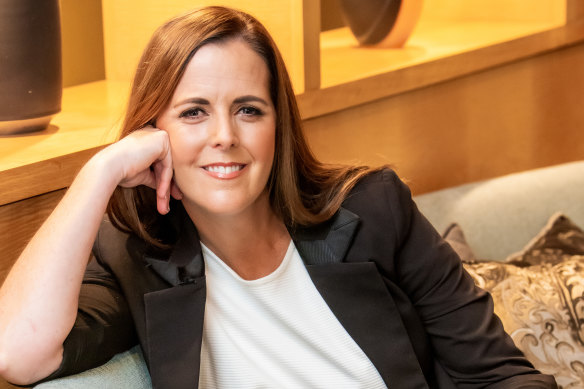This was published 1 year ago
‘It was very isolating’: How Stephanie’s world was turned upside down by incontinence
By Evelyn Lewin
Before having her first baby, Stephanie Watson knew little about urinary incontinence. While she’d seen ads for women in their 70s using incontinence pads, she “never thought twice” about the issue. But after giving birth to her daughter Elsie eight years ago – in what turned out to be a complicated delivery – Watson’s world was turned upside down by the condition.
“It was very isolating,” she recalls. She felt housebound, as even the simple act of lifting her baby to get her into the car would result in leakage. “Then you think, ‘Well, why bother?’ ”

After giving birth to her first child, Stephanie Watson struggled with urinary incontinence.
Sadly, Watson is far from alone, notes National Continence Helpline manager and nurse continence specialist Janie Thompson. Urinary incontinence, defined as the “involuntary loss of urine”, is very common, she says, affecting five million Australians, or one in four people aged over 15.
The condition can lead to skin issues and urinary tract infections. It can also be costly for those needing incontinence products and medical appointments. And there’s a stigma attached, meaning many people suffer in silence. Plus, the condition can drastically change the way you live on a day-to-day basis.
Watson can attest to that. Before having Elsie, she was a triathlete. After giving birth, she struggled to do even the simplest task, making her feel like a “totally different” person.
While Watson struggled with significant urinary incontinence, Thompson says anyone experiencing any leakage should seek help. However, she adds, there’s a pervasive message that it’s normal to “leak a bit” when women cough or sneeze, so people worry about whether their incontinence is significant enough to even be seeking help. Nevertheless, Thompson can’t stress enough that “any incontinence is not normal”.
It wasn’t until Watson went to see a women’s health physiotherapist a few months after Elsie’s birth that she first heard the message that leakage isn’t normal. That led to a plethora of appointments with specialists. In her quest to find an effective treatment, Watson left no stone unturned.
She says pelvic floor physiotherapy improved some of her symptoms significantly. She also explored surgical options, but wasn’t a suitable candidate.
Thompson says other treatments for urinary incontinence range from simple measures, such as tweaking lifestyle factors, through to medication, devices and surgery. She advises speaking to a healthcare professional about which treatment may be best for you.
Despite everything she tried, Watson still experiences urinary incontinence. But she’s no longer a recluse, nor crushed by her new reality. Physically, her symptoms haven’t improved, but she has better options for dealing with them. For instance, instead of the bulky pads she used when Elsie was little, she wears reusable leakproof underwear.
Watson is now in far better shape mentally, too. She’s reached “a place of acceptance and unwavering mental strength” and credits this to breath work (which she considers “transformative”) and meditation. Founding the online Bravemumma community in 2019 has also boosted her mental health. Knowing she’s created a “self-haven and empowering space for women facing similar struggles” has helped her more than she could have imagined.
National Continence Helpline 1800 330 066.
Make the most of your health, relationships, fitness and nutrition with our Live Well newsletter. Get it in your inbox every Monday.